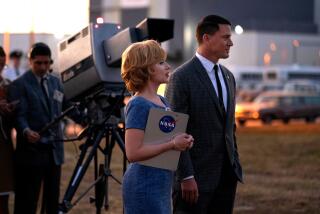Mature Youngsters Find ‘Apollo 13’ Isn’t Over Their Heads
- Share via
In “Apollo 13,” an explosion crippling a spaceship headed for the moon triggers heroic efforts by Mission Control in Houston to rescue astronauts Jim Lovell (Tom Hanks), Fred Haise (Bill Paxton) and Jack Swigert (Kevin Bacon). (Rated PG)
*
The history is 25 years old, the outcome certain. The heroes are men in pocket protectors and horn-rimmed glasses. The story takes more than two hours from blastoff to splashdown.
Most children, those who prefer, say, “Ace Ventura,” were not as riveted to the screen as the parents who brought them.
But still, it is outer space on the big screen. It is as realistic as it gets.
It strings the technical troubles along with high anxiety--including the emotional toll on the astronauts’ children.
Some children--for instance, those who like “E.R.” or “The Right Stuff”--were enthralled.
“A perfect 10,” said Ryan Matsunaga, 12. “It was interesting how they went up to space and couldn’t make it to the moon, and what all the people down on the ground had to do to bring them back safely,” he said.
“I’ve never seen it when it really happened, but now I know what really happened.”
One highlight for Ryan was when the Houston engineers, improvising under time pressure, created a model air filter for the astronauts to copy so they could clean the dangerous air in their wounded spaceship.
The characters’ personal stories also hooked him in, he said.
“It was tragic,” said Ryan, who said that although he shed no tears, “my mom did.”
Aaron Mills, 8, liked the scene when a disappointed Lovell imagines himself walking on the moon, pulling his gloved fingers through its thick, gray dust. Like the other kids, he enjoyed the loud, fiery explosions the most.
Most kids said they didn’t understand the technological jargon explaining the ship’s problem and how the rescue was affected. But, surely, neither did many adults.
Some said the movie educated them about space travel, such as explaining the precise maneuvers required to enter the Earth’s atmosphere through a narrow window. Others were left with questions.
Asked Ryan: “When the space craft goes up there, when they let go of the extra equipment, where does it all go?” (Some floats around in space; some burns up, some comes down and hits Earth, his mother explained.)
When the postscript explained that Haise had died of cancer, Kevin Obermeyer, 10, wondered whether it was connected to the incident.
Some 8- and 9-year-olds figured they would have enjoyed it more if they were older and--perhaps--understood it better. But 6-year-old Jake Tadlock took it all in.
Jake, who loves spaceships second only to dinosaurs, peppered his father with technical questions throughout the movie.
“When they cut loose the command module and it rotated away showing the extent of the damage, he wanted to know what all the stuff was,” his father said.
But then, Jake may differ from many 6-year-olds. He can tell you the model of Chuck Yeager’s plane (Bell X-1). On his first day of kindergarten, when the teacher asked the children what they wanted to be when they grew up, Jake replied that he wanted to be a Marine pilot and parachute out of a C-130.
“That’s Jake,” said his mother.
More to Read
Only good movies
Get the Indie Focus newsletter, Mark Olsen's weekly guide to the world of cinema.
You may occasionally receive promotional content from the Los Angeles Times.










